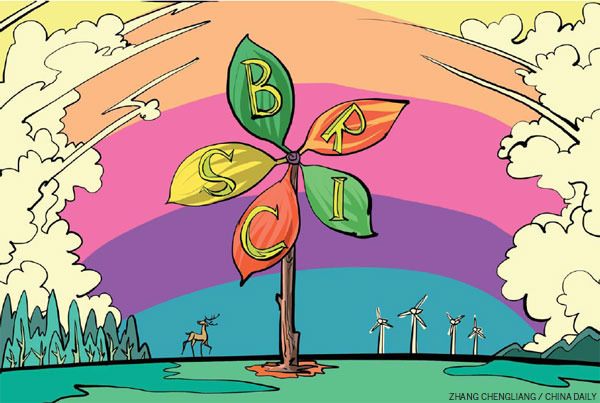Despite challenges, these five developing countries can have transformative power.
Two transformations are likely to dominate the first half of the 21st century. One is the shift in economic power from the West to the East (especially the BRICS countries – Brazil, Russia, India, China, and South Africa). As of 2014, the five BRICS countries represented approximately 40 percent of the world population, approximately 20 percent of global output and an estimated $4 trillion in foreign reserves. Globally and politically, the influence of the BRICS is rapidly increasing.
The second is the transition from a high to a low-carbon economy. Global warming is recognized as the most important risk factor that threatens the very existence and the advancement of humanity. The Stern report in 2006 famously called climate change the greatest market failure of all time. Combining growth patterns and sustainability in terms of economic, social and ecological development is a key challenge for any country.

In the process of transformation, the visions and practical experiences of BRICS countries are of crucial global importance. However, disparate development challenges, diverse economic growth trajectories, and emerging global challenges such as climate change make it difficult to identity and codify development paths for member countries. BRICS countries are facing an increasing challenge to sustain economic growth, save natural resources, and protect the environment. According to World Resources Institute, China, India, Russia, Brazil and South Africa ranked 1, 4, 5, 6 and 12 in global greenhouse gas emissions in 2013.
Outside pressure is mounting on BRICS to deepen commitments to address climate change. Moreover, all the five countries are vulnerable to climate change and the impact of global warming is increasingly apparent. It poses a significant threat to water resources, food security, health, infrastructure, as well as its ecosystem services and biodiversity.
In recent years, the five countries have deepened cooperation through bilateral and multilateral channels on some major issues, such as the reform of the international financial system and global-trade negotiations. Bilateral cooperation is an important path to tackle climate change. As early as in 2005, China and India began to cooperate on energy security. The two sides set up a joint working group to exchange views on major issues in global climate talks, domestic policies and measures, and implementing projects. In 2010, the China-Brazil Center for Climate Change and Energy Technology Innovation was set up at Tsinghua University.
But collaboration on climate change through the BRICS mechanism has encountered some barriers, such as the lack of the necessary infrastructure for the successful development of green energy, the inadequate level and quality of climate-friendly technology, low levels of green financing, and institutional and regulatory constraints.
Much work needs be done to offset the problems and central to this is to set up a BRICS green paradigm based on principles of inclusive green development and mutually beneficial sharing models. Such sharing models will enhance cooperation on climate change. Some priority areas and suggestions for what the BRICS green paradigm should entail are:
First, political leadership and willingness to settle differences, mutual understanding, and strong regional relationships will be required to support the transition toward low-carbon development among BRICS. The United Nations Climate Change Conference will be held in Paris at the end of 2015. It is crucial to reach a meaningful and universal agreement. The BRICS countries, on the basis of equity and in accordance with their common but differentiated responsibilities and capabilities, can enhance political trust and take more forceful measures to encourage new efforts. Both multilateral and bilateral meetings will help to address key sticking points before the UN Climate Change Conference.
Second, sharing of scientific and local knowledge among BRICS is vital, especially for managing resources such as water and forests. Collaboration on clean energy and energy efficiency offers a real opportunity to deepen the overall BRICS relationship. In accordance with the principles of mutual complementarities and mutual benefit, the BRICS countries can make full use of their respective advantages to advance cooperation in hydropower, nuclear power, wind power, solar power and other clean, renewable energy sources, and to strengthen technical cooperation in the field of green energy by setting up a new-energy cooperation mechanism. BRICS countries can host a clean energy forum, jointly establish a technology research and development center, or encourage collaboration between well-known universities and research institutes. BRICS can also set up task forces with senior government officials, independent experts, industry and financial community leaders and NGOs to develop programs and guide implementation.
Third, building synergies through green knowledge sharing and development assistance to lower-income countries will be important. It is feasible to establish a green channel to promote clean energy trade, and environmentally friendly technology transfers to less-developed countries. Progressive steps need to be taken to facilitate access to climate-friendly technologies for developing countries.
Finally, the policy environment should be made conducive for increased financial flows to meet funding requirements for infrastructure and sustainable development. BRICS can promote green progress in the New Development Bank’s investment activity. Clean energy infrastructure in many BRICS countries is weak and government financing is limited. The BRICS Development Bank can provide long-term and low-cost financing support to promote the development of clean energy in BRICS or other developing countries. A green fund under the BRICS Development Bank can be set up to finance green projects and assist in deployment of renewable energy sources and technologies.